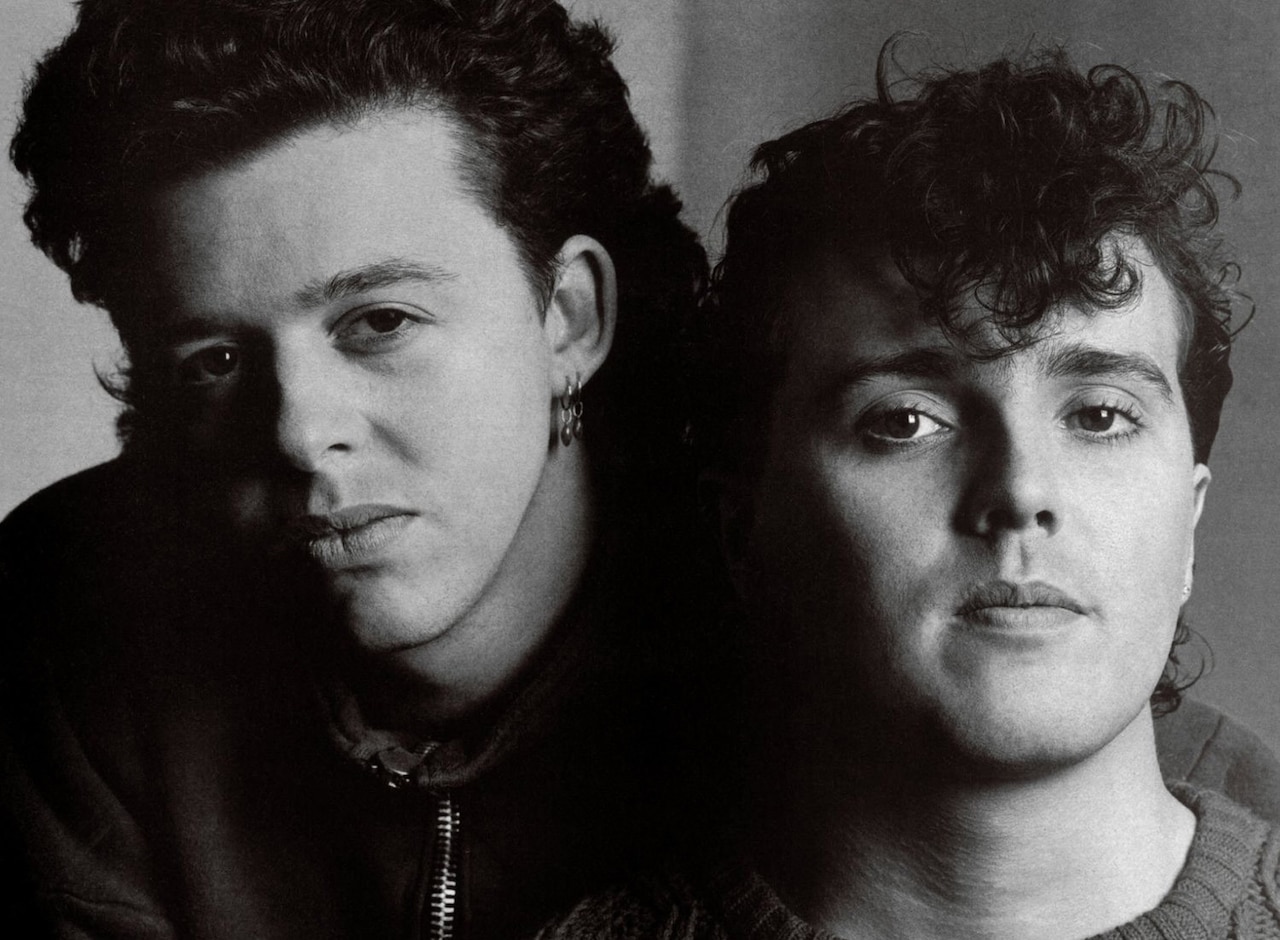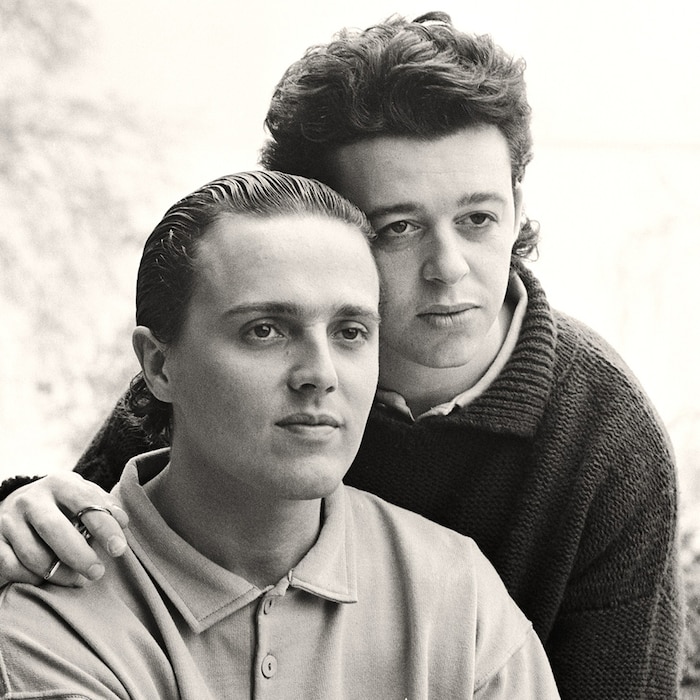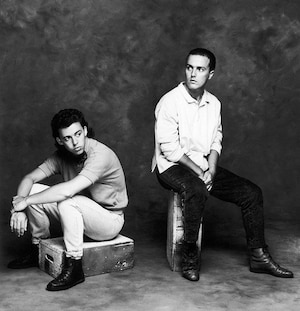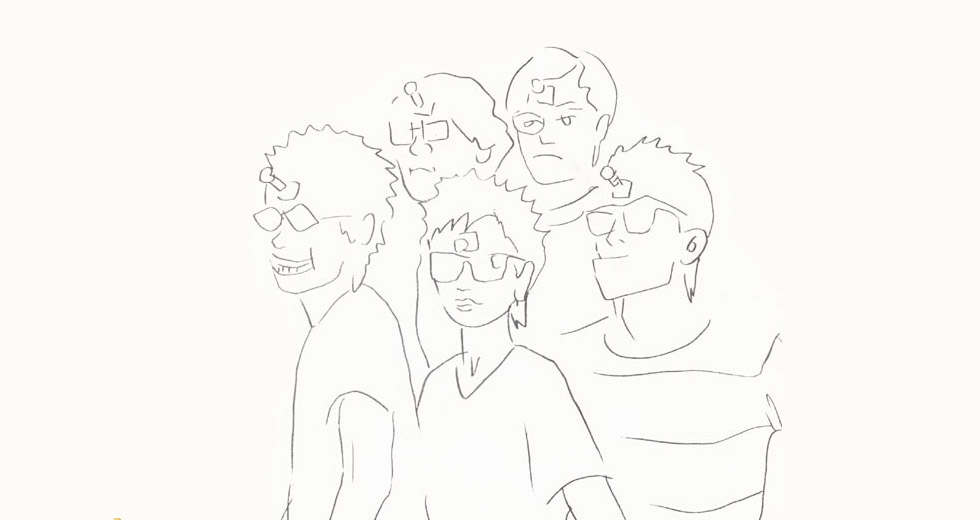Key Tracks: Tears for Fears’ Songs from the Big Chair
A behind-the-scenes look at one of the biggest albums of the ’80s.

By the mid-’80s, Tears for Fears had established themselves as breakthrough artists with a promising future. After meeting as teenagers in Bath, Somerset, in South-West England, Roland Orzabal and Curt Smith formed Tears for Fears, and eventually signed a record deal with Phonogram Records in 1981. Two years later, they released their platinum-selling debut album, The Hurting.
During the making of that record, they forged a musical kinship with upstart producer Chris Hughes. Their relationship would continue on to the next record, a follow up called Songs from the Big Chair. It spawned five singles, including two number one smash singles “Shout” and “Everybody Wants to Rule the World.” For the album’s 30th anniversary, we spoke with Hughes about his role in the record.
You played a pivotal role in the making of Tears for Fears first album, The Hurting. How did you start working with the group?
This story goes back quite a long time. There is a guy that is important to the whole story who was the A&R guy back then. His name was David Bates. He was working with Tears for Fears. They had done some recordings before their first album. There had been an issue with some recordings they had done, and they weren’t happy with them and the label thought one thing and the band thought something else.
I just happened to be in the offices when there was a phone call between David Bates and Roland from the band. David said, “Listen. Why don’t you speak to him? See what concerns him and what his issues are.” I had a conversation with him having never met him. We chatted for a while about the nature of recording and what an artist wants to achieve and who they want to work with and all those kinds of things.
Fast forward some time later, when they were trying to put together who might produce the album, Roland allegedly said, “I’d like to work with that guy I spoke to on the phone.” I was living in London, and they were living in the West Country in England. I caught a train down there, and I met them. We chatted and we got on OK. Fairly soon after that, we came to London and recorded a track called “Mad World.” So, this was the start of our working relationship. This was either in late 1981 or early 1982.
When you first started working with them on their first album, did you see the potential for them to have breakthrough success?
Yes. I think it was very obvious they were extremely musical. Roland [Orzabal] had been writing songs quite well for some time, so the batch of songs that were put forward for that album was of high caliber. I must admit, I thought they were very talented players as well. They had good keyboard, bass, and guitar playing skills. I’m about seven years older than those guys. I had made records prior, and I had been in bands and knew enough, I suppose. I think they regarded me as an older figure whose opinion may be valid in certain areas. So – yeah – we got on pretty well. To this day, I remain good friends with the both of them.
The Hurting ended up being a platinum-selling record. Coming off the success of that album, as the producer for the group, what direction were you trying to take their sound for Songs from the Big Chair?
After the first album was released, naturally, they went off and did their own thing. They were young pop stars, so they were doing tours, TV, and all that kind of stuff. I went off and did a Wang Chung album. When I finished that, I got a call from the group saying that they were looking to start their second album. They asked me if I wanted to hear some songs and to become involved again. It was quite easy, because by then, I knew them very well. When you’ve shared some success, those dialogues are always easier.
He pressed one of the keys and started singing, “Shout. Shout. Let it all out.”
The opportunity to work on their second album was a great opportunity, but what is worth mentioning is that we got off to a rocky start. We started working on it, and they were various issues with how the record was going to be made and lots of stuff. In fact, there came a point where Roland said, “We kind of want to do this record on our own.” I think there was a short period of time where it looked like I wasn’t going to produce it because they had enough of – perhaps the old way of doing things. I think they worked on it for a couple of weeks, and then I got a call from them and they said, “On second thought, we would like to make this work.”
So that is really when the album started and, in fact, the vibe working on that album was great. We worked on it with a keyboard player named Ian Stanley who was also a co-writer on some of that record. We basically camped out at his house. The studio there was his own of kind of hobby studio, really. It wasn’t like a professional recording studio. We just built the record up over time at his place. It was essentially Roland, Ian, and I working together as a three piece. Then, Curt [Smith] would come in and be involved with vocals and other ideas, but essentially, the day-to-day operations on that record was Roland, Ian, and I with Dave Bascombe who was the engineer.

While working on this album, were you and the group influenced by any of the burgeoning New Wave music being released by your peers or were you all more concerned with building on the foundation you laid with the success of The Hurting?
The truth is both of those things were happening at the same time. Clearly, we understood the nature of electronics, synthesizers, and all the cutting edge technology that the first album had. We were experimenting with sounds and electronics. This was pretty much the pop idiom at the time. There were a lot of bands doing the same thing like Depeche Mode, so we were aware of all that, but also we used to sit around and listen to other things like Robert Wyatt, The Beatles, and lots of bands that were contemporary and older influential bands. There was a lot of music around, and we knew a lot of stuff. There were influences all over the place. I think the second album is much wider as a musical palette than the first album.
From your standpoint, who led the charge of coming up with melodies, harmonies, and arrangements for each record?
Well, they varied. There were some songs that Roland wrote completely on his own and had a pretty strong idea on how they should go. There were other songs that were collaborations that needed extra work. Some tracks would just sit in the studio. Primarily, it would be Roland, Ian, and I working things out like harmonies and building decorations and other elements to the songs. Input came from everybody at different times, but the main arrangements and the building blocks of how the tracks would go were sorted out by Roland, Ian, and I.
Can you take me through the group’s collaboration process of building the songs from this album?
I could, but it would take a long, long time because each one has its own story. I distinctly remember the making of “Shout.” I came to the studio on a Monday morning after the weekend, and Ian Stanley walked in and he said to me, “I went over to Roland’s house on the weekend, and he played me a little demo with a drum box and a little synthesizer. I don’t think he has recorded it yet as a demo, but you got to get him to play it for you.” So when Roland arrived, I said to him, “Ian tells me that he heard a new song that you got. Play it for me.” He set up a little drum box and a little synthesizer with a bass tone. He pressed the button on the drum box, and he programmed this little beat and it had these little chimey bells and a clapping drum beat. He pressed one of the keys and started singing, “Shout. Shout. Let it all out.”
It was astounding. I said, “Guys, we have to stop what we’re doing and record this now.” We spent months building that song from Roland’s original, unrecorded drum box and synthesizer idea. We spent months looking at rhythm, adding other drums, I played drums on the track, there were two drum boxes running, there was a Fairlight computer doing electronic stuff in the middle playing flute parts... That song was arranged by Roland, Ian, and I. It was essentially a Roland song, and Ian wrote, quite quickly, a medley which was a power piece in that song. Getting this track written, arranged, recorded, and mixed took months and months. Day in and day out we were working on it. It was a long slog to get that as great as we could get it.
The original recording was seven minutes long, but it got chopped down a bit. There were guitar solos in it. Up until then, there weren’t many synth bands putting in guitar solos.
It was a long piece. The original recording was seven minutes long, but it got chopped down a bit. There were guitar solos in it. Up until then, there weren’t many synth bands putting in guitar solos. It was a long track that we built piece by piece by putting another verse on it and expanding the middle section. There was another little synthesizer break thing which Roland came in a few days later and said, “We need to put this in, we need to punctuate it, and break the track up.” So – we would come in and do bits and pieces for months.
While that was happening, every now and then, Roland would pick up a guitar, and he would be strumming two chords. I remember asking him, “Do you have something? What is it?” He replied, “Oh. It’s nothing. It’s just a couple of chords.” So I wrote the chords down and programmed the little drum box and these two chords. Every now and then, when we had a break, I would sit there listening to this programmed beat and these two chords.
I kept saying to Roland, “You really, really must write a song with these two chords. It’s so great.” He wasn’t interested. One afternoon, his wife came into the studio and she heard me playing it, and she asked, “What’s that? What’s that? It’s great! It’s great!” I said, “Tell your husband because I’ve been telling him for two weeks now that he needs to write a song to it.”
Anyway, he came back a couple of weeks later, and he said, “Well, I haven’t got the song, but I have the two chords and I have a melody which goes, ‘Everybody wants to rule the world.’” I said, “Let’s write it now. Let’s make that song.” So Ian, Roland, and I sat down and wrote, recorded, and finished that track within a week. It was super quick. It didn’t take any time at all. It kind of built itself, meanwhile “Shout” was still waiting to be finished. [laughs] Those were two songs that were successful songs, but one took forever and one was done super quickly. I worked on those two tracks in my sleep. [laughs]
What were the names of the drum boxes and synthesizers you were using?
There were lots. We had a LinnDrum II box, a drumulator drum box, a Roland Super Jupiter synthesizer, a Fairlight synthesizer, a DX7 keyboard, a rack of guitars, a Steinberger Bass, a Fender Stratocaster and a Gretsch maple drum kit. Those instruments were the kind of workhorse elements to the sound.

What did you feel like your role should’ve been as the producer of this album?
Well, I think, for me, the key thing is to try to make everything make sense. You have to understand that Roland and Curt had made a successful record. They knew how to make a record, they knew how to write songs, and they knew how to play them. It was just a case of keeping their sound together and making sure the songs were arranged well. In the studio, it was a collaborative process.
I’m not trying to exclude Curt at any point in this interview. He wasn’t excluded. He was around and he would come in and be helpful and optimistic. He would sing, but he wasn’t the core of the ideas. The core of the ideas was Roland, Ian, and I. Curt had the power of veto. If there was something we were doing that he didn’t like, of course he would say so. He came in and made loads of positive suggestions and did loads of singing and bass playing, but he wasn’t actually in the core of the decision making and creative processes at the time. I’m not excluding him on any level because his involvement was invaluable. It’s just that he wasn’t there daily.
What was your and the group’s studio routine during the making of the album?
We would start working in the studio around 10 in the morning, and we would finish around supper time at about 7 or 8. It would depend, though. Obviously, if we were on to something and we didn’t want to let it go or finish a section of something, our session would go on later and then we all might hang out and have a beer and maybe play some board games or something.
Some of this record was done in quite intimate situations. We worked some of the music out on a sofa. We weren’t in a big corporate recording studio.
There would be people hanging around. Our friends would come by. The house was quite large. During the evenings, girlfriends and friends would turn up. It wouldn’t be party time, but there was a good social scene.
We would work exclusively from 10 to 7 or 8. The day would be a continuation from the day before. We would come in and put the tapes up and have a listen to what we did, swap things around and leave it for a bit and move on to a new tune or go back to a tune that needed something. Quite often, we worked on a song, and we would get a guitar sound and we thought it was a beautiful sound and we decided we could use it on another track.
Sometimes, we would have two or three unfinished tracks going around, and we thought it’s not working on this track, but it could be brilliant for another one. As a result, we would swap tapes. We were working on two or three things at once except for when we did “Shout.” We would be in the studio five days a week.
The other thing to note is that a large amount of this record was mixed in Germany because Roland had the idea of working on an SSL desk and it was an opportunity to go to other studios that had this similar type of desk to do mixing. So we found a studio in Munich, Germany and before we started mixing, we had a few days of skiing. It was a nice studio in the suburbs of Munich. We were there a while, but we didn’t finish mixing there. We came back and mixed at various studios in London.
What were the steps involved with mixing this album?
The process was the process. All of us were involved with mixing the records. Sometimes, it was more beneficial if some people weren’t there all day, so they could come in and hear it later in the day, as opposed to hearing it through the process. Then, they would say they liked this or didn’t like that. It was just objectivity from the band, you know.
There were some songs that kind of mixed themselves and others that were a pain. For instance, “Shout” was a pain to mix. It was just difficult. It almost sounded right for a long time, but wasn’t quite right. “Everybody Wants to Rule the World” was a breeze to mix. “Mothers Talk” took a bit of time to get right. We didn’t get it right the first time. “Shout” was the hardest to mix.
Specifically, what was difficult about mixing “Shout” and “Mothers Talk”?
I think they were difficult because there was a lot on the tracks. We recorded a lot. It was one of those things where a track could go a certain way. We would listen back to a mix and say, “Yeah. That tells half the story, but it’s still better than this.” A lot of it was self-policed. Some of the tracks we got straight away and others took a few takes.
What were the differences between Ian Stanley’s home studio in England and the studio you used in Munich, Germany?
The essence of the album was recorded in Ian’s house. I recorded drums in a tiny room off one side and some of the drums were recorded in a big lounge. There was a grand piano sitting in the living room. We recorded some saxophone in Ian’s office. Lots of different parts in the house were used at different times.
The record was very organic. We would record something in a certain place. There was no soundproofing. Sometimes we had the doors open. We had free run of the house, and we did anything we wanted to do. That was our recording process. There were a few other bits of recordings that were done because we needed more organized drum separation and bass part separation.
We recorded some bits and pieces in Jethro Tull’s studio in Chelsea. We did some mixing in Primrose Hill in London. It was a full-fledged, proper mixing suite studio, similar to the one in Munich. They were of their day. They were totally professional, great quality, great facility recording studios where we mixed the songs. The bulk of the record was recorded in Ian’s house. Some of the workings of the record were done in quite intimate situations. We worked some of the music out on a sofa.
We weren’t in a big corporate recording studio. The music was done in the middle of the afternoon sitting out on a balcony thinking about something and having a cup of tea and then popping back down into one of the rooms to record something. It was very, very organic. I know that word is used a lot, but it was. It was a special time to be recording.

